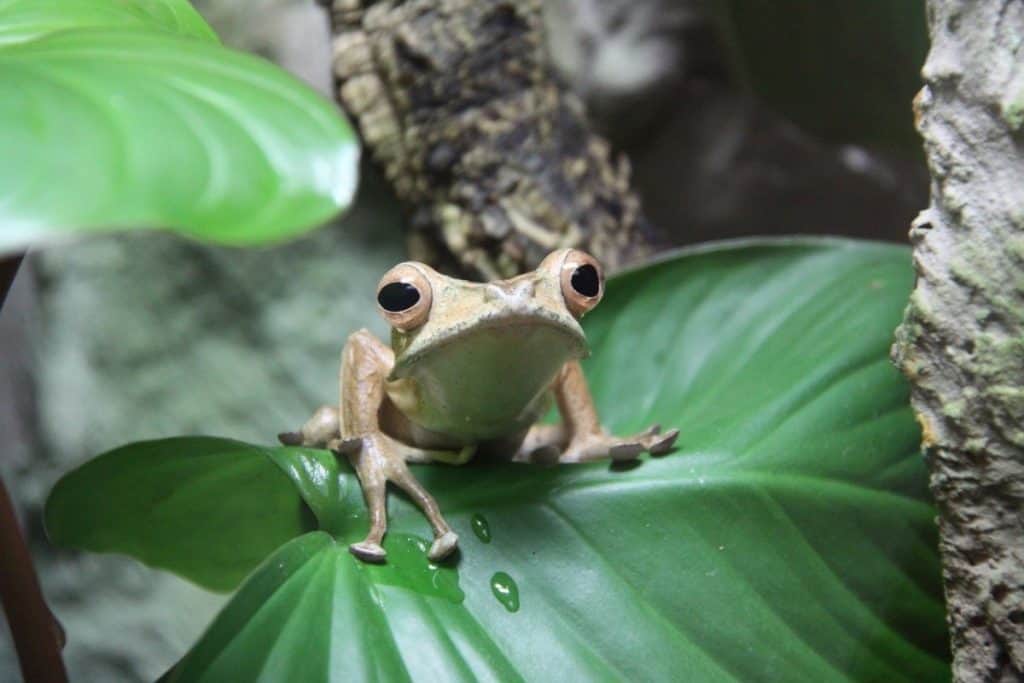There is something extraordinary about hearing frogs and toads croaking, but do you know why they make this noise. Frogs and toads communicate using a variety of calls and listening to them with organs that are unique to them.
In most species, only males croak and are used to attract females to mate. However, frogs also use other croaks to communicate. Frogs will warn others to stay away by using territorial or aggressive calls. Advertisement calls signify that they are in the area, and distress calls that sound like screams are used when faced with a predator.
Because toads are a classification of frogs, I have mainly used the word frog in this article, but most toads also croak in the same way.
Do you know how amphibians breathe? It may not be how you think. Find out more here

A frog chorus
A frog chorus occurs when thousands of male frogs call simultaneously and in the same area. These choruses are not just made by one frog species but by up to two dozen. Because there are so many males calling, they can be heard over 1 kilometre away. Their calls attract females for mating, and the mating occurs around water where the spawn will be fertilised and laid.
Arriving at these areas with thousands of frogs, females must find a suitable male from their species. Even though the noise is intense, females can determine the call from their species. They will also use their sense of sight and smell to find a suitable male, but the sound is the most predominant sound they use to locate a partner.
Each species has its unique call, something that humans can distinguish and their prospective mate.
Do you know why some amphibians are brightly coloured? Find out here
Different calls
The sounds that frogs make are varied, although some are used for more than one meaning. The call used for mating is also used as an advertisement call to indicate their presence. This tells other frogs, male and female, where they are, attracting mates and warning off rivals.
A male communicating with another male may add extra notes to their call or may use an entirely different one. These are known as territorial, aggressive, or encounter calls. These calls can interrupt their rival, making them less attractive to females or to signal an attack.
Females will not react to aggressive calls unless there are no other frogs making advertisement calls. Females may leave the area if two males argue to find a frog.
Advertisement, warning, and mating calls are not the only calls frogs, and toads make. Although similar in structure and tone to a warning call, release calls are used when a male is in the grips of another. Females may also use the release call if they are not interested in the male, and it is usually enough for the male to let them go.
While most calls are made with the mouth closed, distress calls are given with the mouth open. If a predator attacks a frog, a distress call will be made. This is much louder and is almost like a scream in some species. This scream can momentarily shock the predator allowing the frog their escape. Other frogs do not react to distress calls, possibly to ensure they are not the next meal.
As the main reason for the calls is to find a mate, it is thought that females will listen to the calls for more information on their prospective partner to choose the best one. As the largest males produce the lowest frequency calls, females prefer males with these calls. The larger a frog or toad, the older they probably are.
Due to the high predatory rate of frogs and toads, one that has lived longer may have adaptations that the female wants her young to have. An older, larger male often has better genes that allow them to avoid predators and find food.
However, this isn’t the same for all species, and it is sometimes that the larger males chase off smaller males from territories where females lay their eggs.
Do you know what caecilians are? If not, find out here.
How calls are made
Frogs and toads have vocal cords that are located in the larynx. Calls are generated by vibrating the vocal cords when exhaling a lot of air. However, some species can make sounds when inhaling, such as the fire-bellied toads of Europe and Asia.
Frogs have vocal sacs that they inflate. Although it acts as an amplifier to the sound, it doesn’t add energy to it. The vocal sacs help to couple the vibrations to the surrounding air. This is similar to how a guitar string produces the sound, but the wood increases it.
Frog calls can be made at different pitches by filtering out other frequencies. Different calls can be made by adjusting the duration. The spotted grass frog makes a short click of 5-10 milliseconds, and the American toad makes a long trill that can last about ten seconds. The Great Plains toad can last several minutes. This is made by air moving backwards and forwards across the larynx between the lungs and the vocal sac.
Sounds are also different not just in their length but in their quality. The spring peeper makes a whistling noise, and the squirrel tree frog makes a duck-like quack.

How frogs hear
Frogs that trill their calls use one of two methods. The air from the lungs is pulsed by rapidly contracting the body muscles, or the larynx may break the air into pulses.
These calls wouldn’t be needed if frogs and toads couldn’t hear. Frogs and toads have eardrums, and these are located behind the eyes. A pathway connects the eardrums, and soundwaves are listened to from the outside and inside the other ear. The eardrums transfer sound through the middle ear bones to the otic, a fluid-filled capsule. These contain the basilar and amphibian papillae.
Amphibian papillae are only found in amphibians. The cilia of hair cells bend when sound waves hit them, resulting in nerve impulses sent via the brain to the auditory nerve. The basilar papillae also contain hair cells. The frequency sensitivity of the amphibian and basilar papillae match the frequency calls of their species, allowing them to pick out their species among hundreds of others, especially in a frog chorus.
The two papillae can be tuned to two different frequencies, allowing each to hear various frequencies of the calls. This helps the frog find their mate, although the difference in lengths and trills is also significant.
